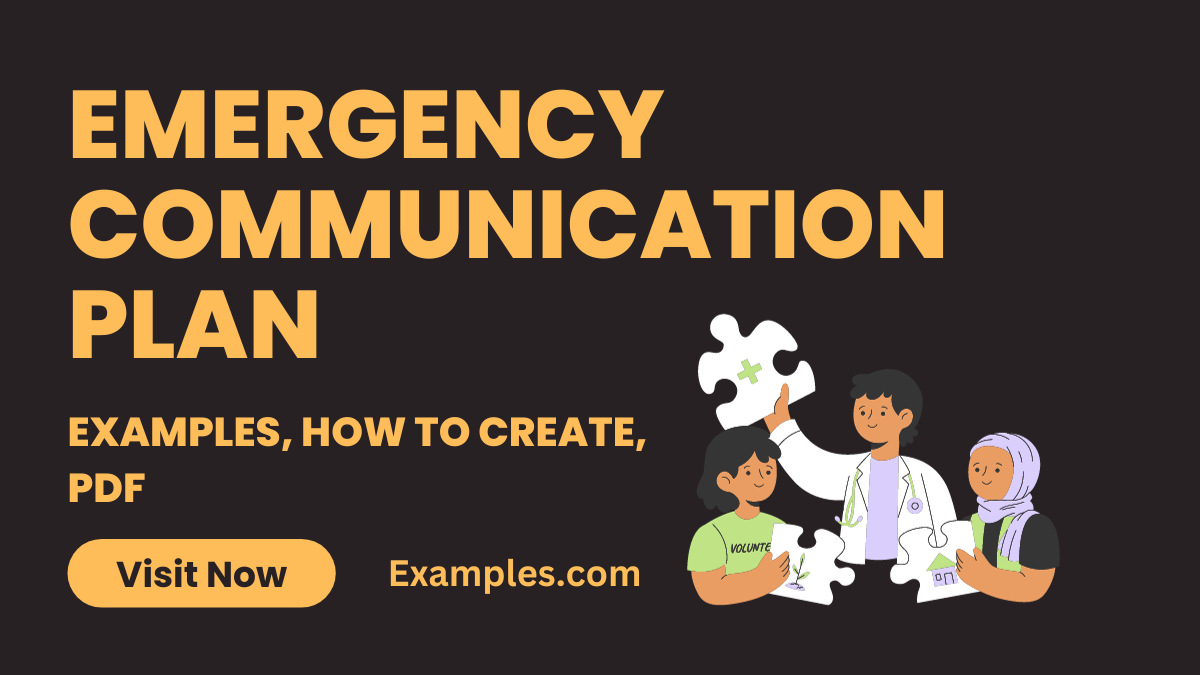7+ Emergency Communication Plan Examples
Emergency Communication Plans are crucial in navigating the complexities of relationships. They serve as a roadmap for couples to address challenges like miscommunication and emotional disconnection. This comprehensive guide delves into various facets of these plans, offering real-life communication examples and strategies. From understanding the signs of breakdown to exploring practical solutions, this guide is tailored to help couples enhance their communication skills, foster trust, and rebuild intimacy. It’s an essential tool for maintaining healthy, resilient relationships.
Download Emergency Communication Plan Bundle
Emergency Communication Plan
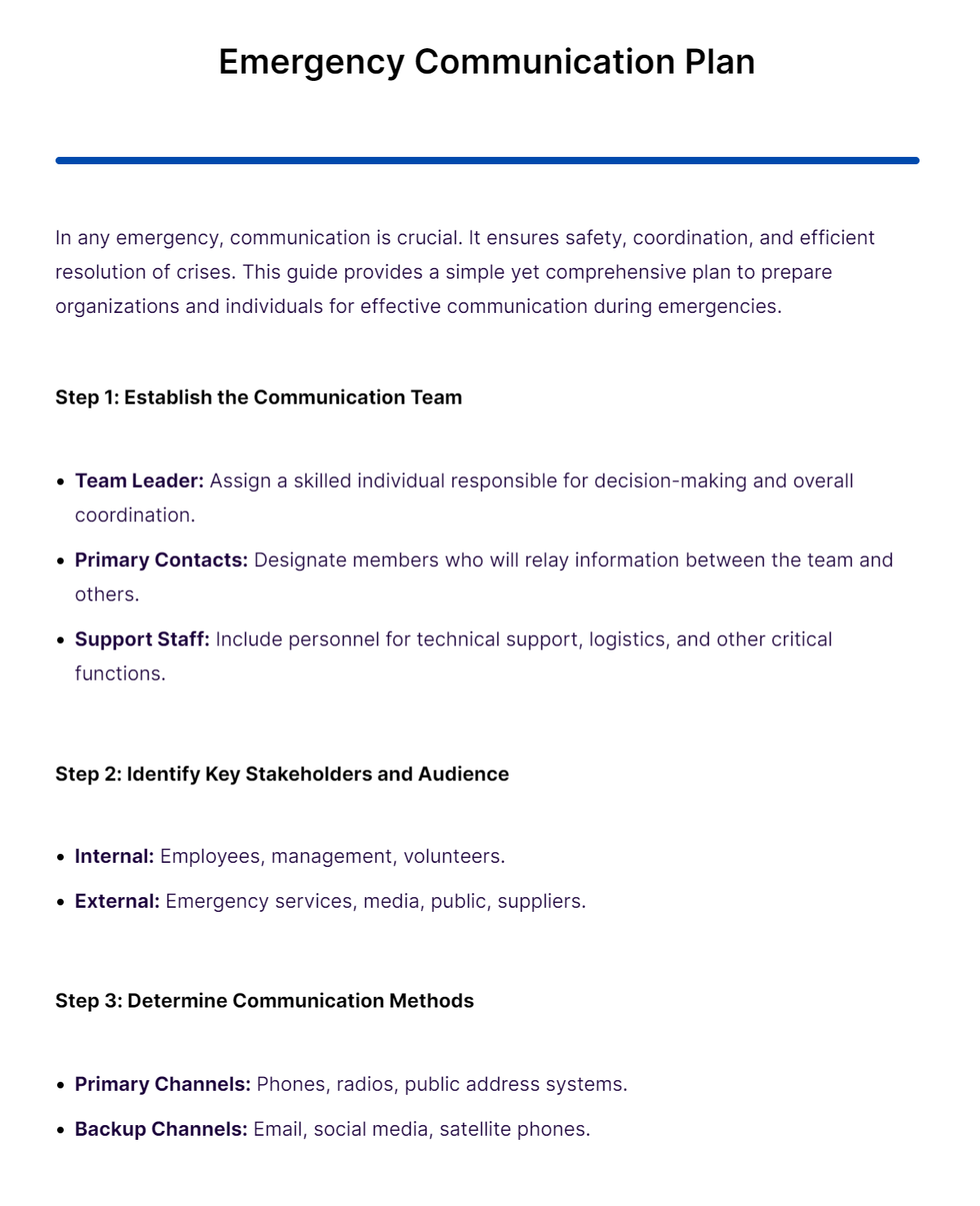
The document on Emergency Communication Plan Examples at emphasizes the critical role of communication in emergencies. It underscores how effective communication ensures safety, coordination, and the efficient resolution of crises. The guide offers a straightforward yet comprehensive approach to help organizations and individuals prepare for effective communication in various emergency scenarios
Family Emergency Communication Plan
The document on Family Emergency Communication Plan is a thorough guide for creating a detailed and practical strategy to keep families prepared for emergencies. It covers essential aspects like contact information, evacuation routes, communication methods, and emergency kit contents, ensuring each family member understands their role and responsibilities. This plan is an invaluable resource for maintaining safety and organization during unforeseen situations
Emergency Communication Plan for Business
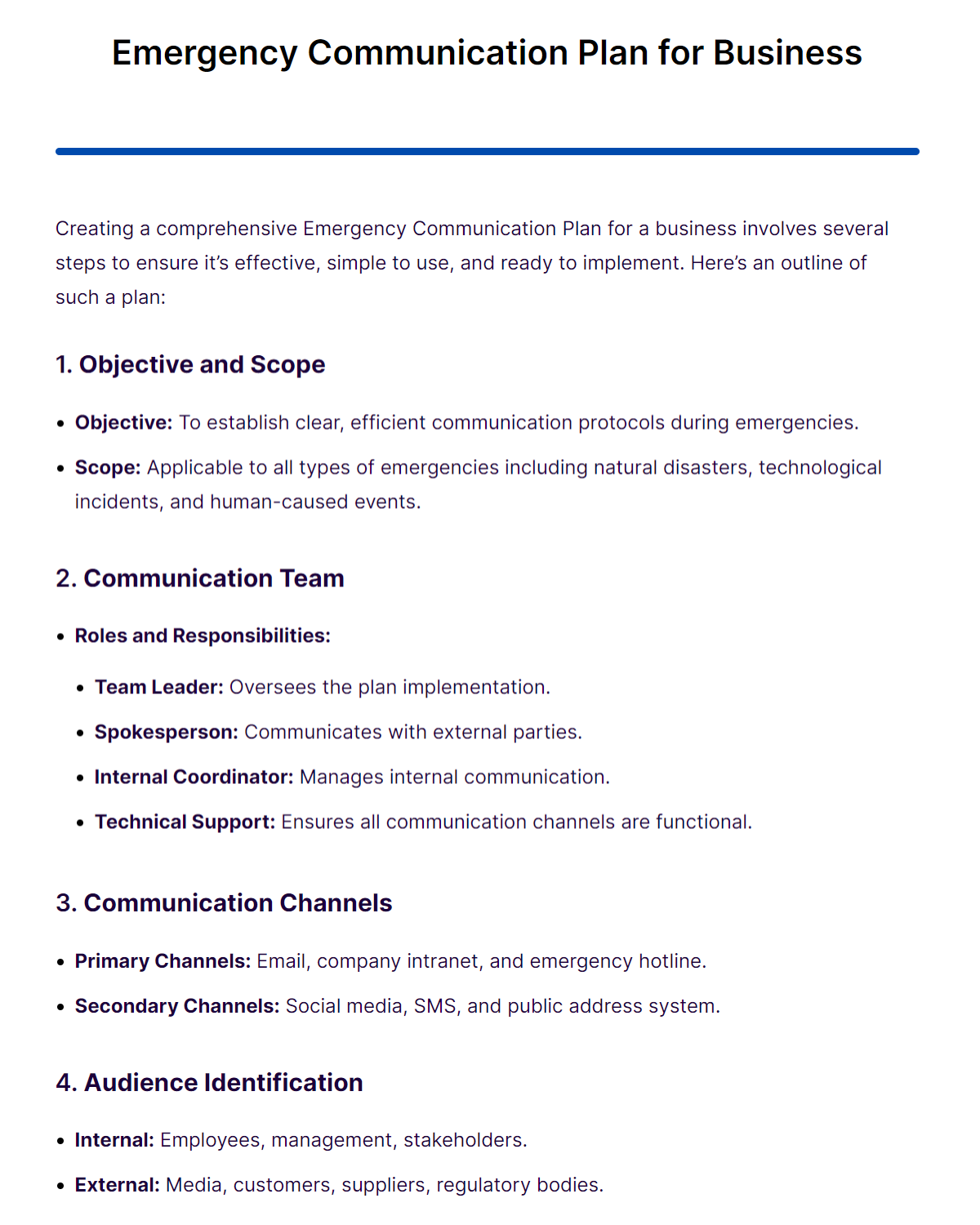
The Emergency Communication Plan tailored for businesses. It covers essential steps from establishing clear objectives and defining the scope to identifying communication channels and audiences. The plan includes roles and responsibilities, message development, procedures for activation and deactivation, training and drills, and methods for monitoring and feedback. Additionally, it emphasizes regular updates and includes visual aids like flowcharts and checklists to enhance understanding and implementation.
Hospital Emergency Communication Plan
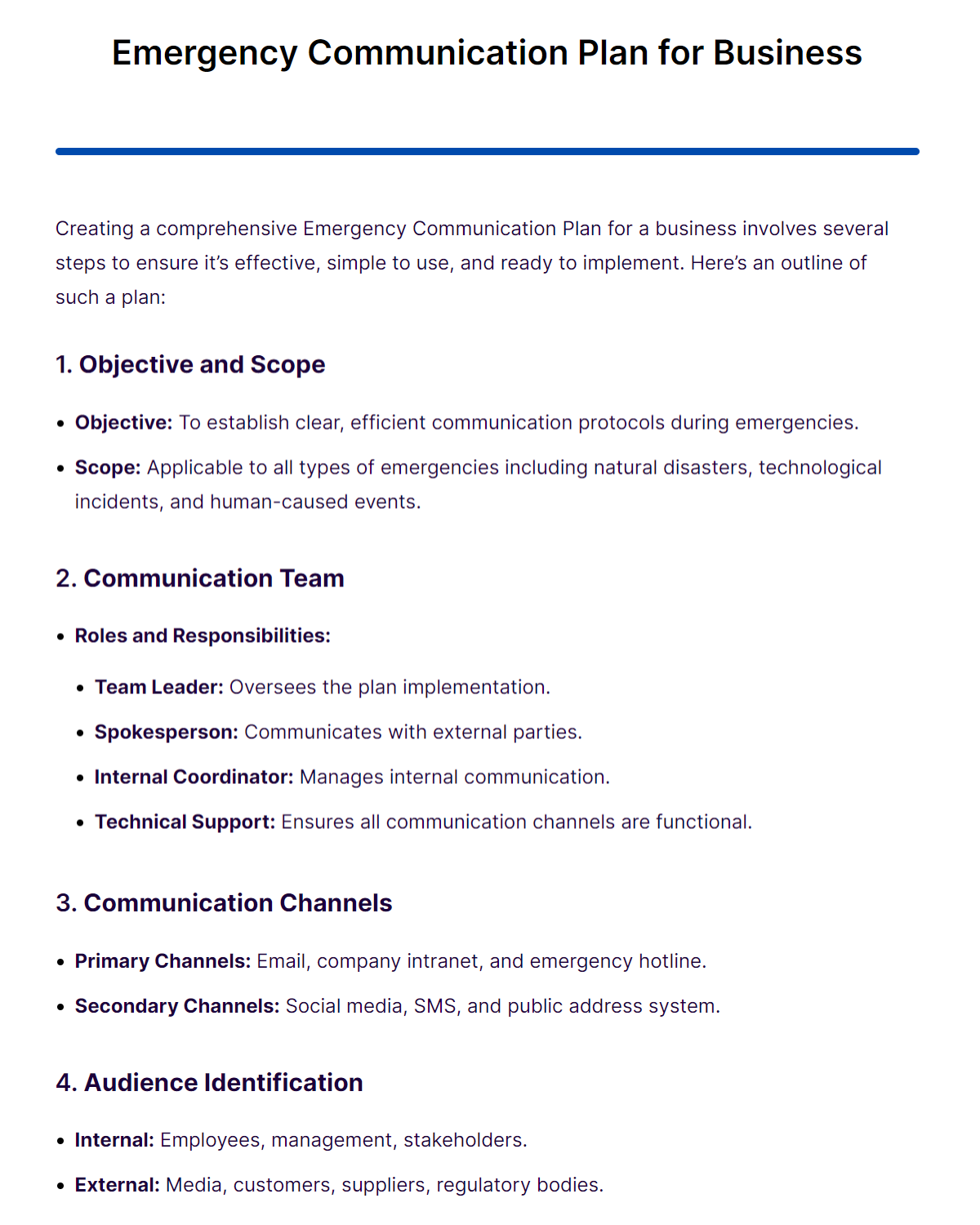
The document on Hospital Emergency Communication Plan outlines a detailed approach for managing communication during emergencies in hospital settings. It covers various aspects such as defining clear protocols, assigning key roles, establishing communication channels, and handling different emergency scenarios. The plan emphasizes the importance of clear, timely communication, efficient decision-making, and ensuring the safety of staff, patients, and stakeholders. It also includes training and drills, information dissemination strategies, and regular reviews and updates of the plan, complemented by visual aids like flowcharts, tables, and graphs for effective communication management plan.
School Emergency Communication Plan
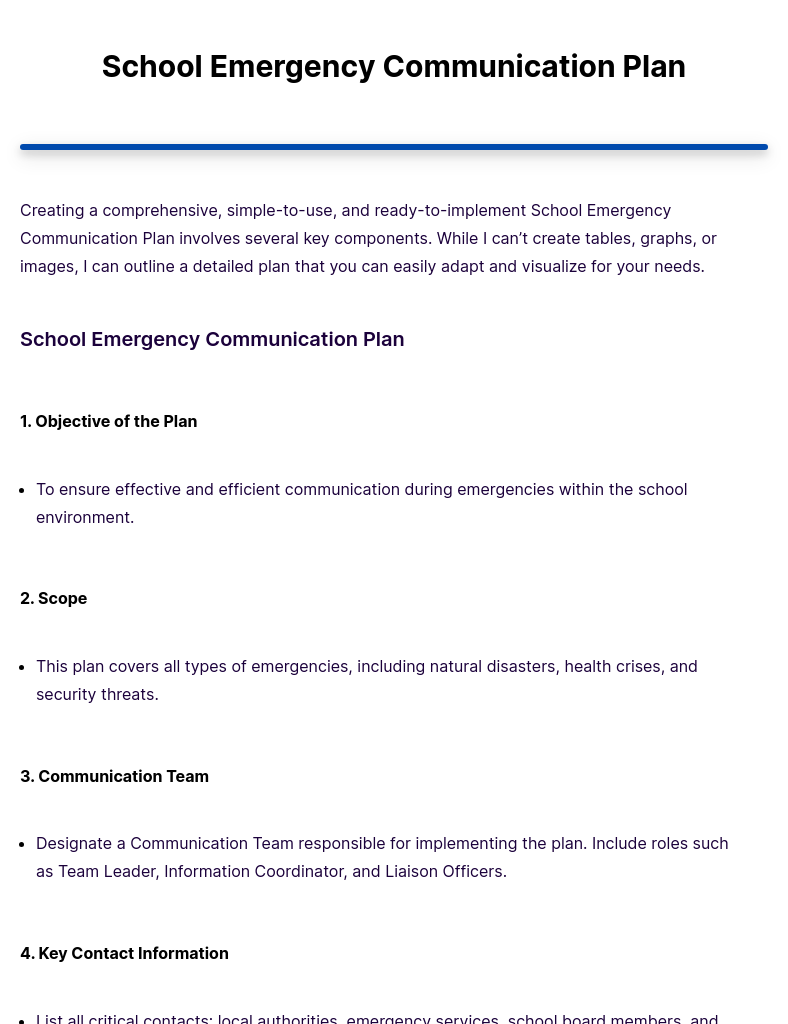
The School Emergency Communication Plan outlines a detailed strategy for effective and efficient communication during various emergencies in a school environment. It covers aspects like the objective, scope, team structure, key contacts, communication channels, message development, information flow, training, and regular updates. The plan is designed to address natural disasters, health crises, security threats, and includes special considerations for individuals with unique needs. This comprehensive guide is an essential tool for schools to prepare for and manage emergency situations effectively
Emergency Management Communications Plan Template
Resident Emergency Communications Plan
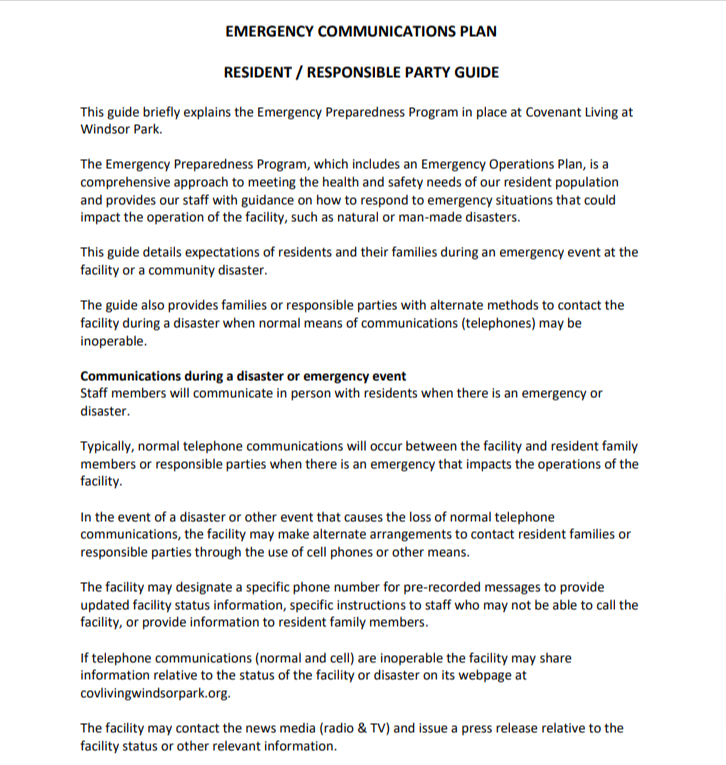
covlivingwindsorpark.org
DownloadNational Emergency Communications Plan
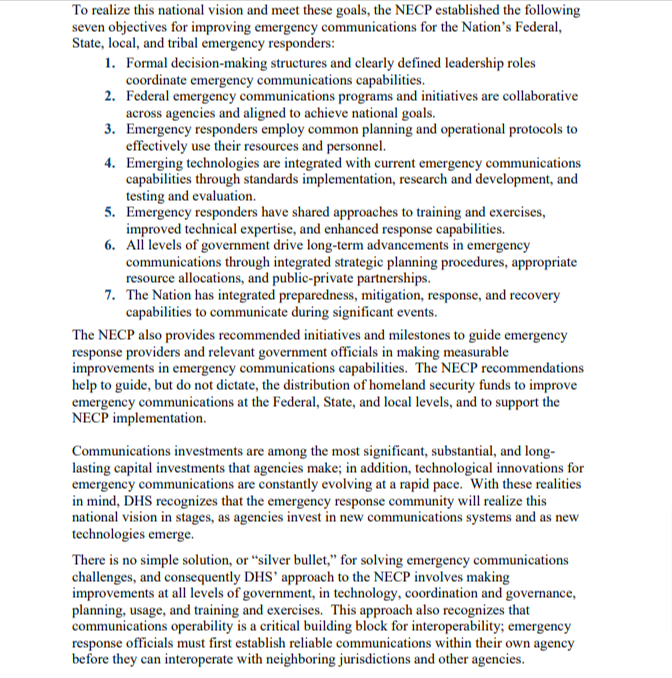
cisa.gov
DownloadEmergency Communications Plan Checklist
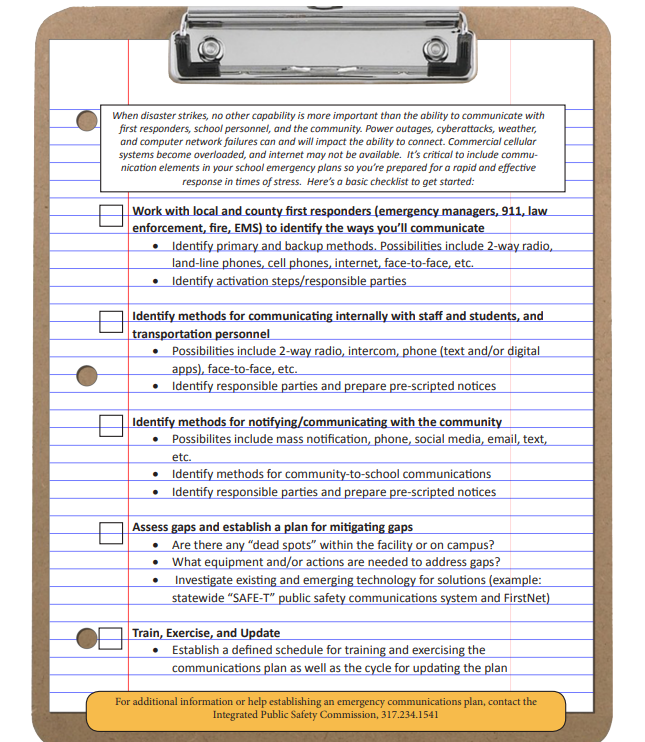
in.gov
DownloadDeveloping an Emergency Communications Plan
Developing an Emergency Communications Plan is pivotal for ensuring safety and coordination during crises. This process involves strategizing how to efficiently convey critical information in emergencies. It’s about creating a reliable system that ensures all stakeholders, from management to staff, are informed and prepared. A well-crafted plan minimizes panic, streamlines responses, and maximizes safety.
- Fire Evacuation Plan
- Explanation: Designate evacuation routes and assembly points.
- Example: “Attention all staff: Please proceed calmly to the nearest exit and assemble at the designated area.”
- Lockdown Procedures for Security Threats
- Explanation: Establish procedures for securing premises during threats.
- Example: “Lockdown is now in effect. Secure your immediate area and await further instructions.”
- Severe Weather Alerts
- Explanation: Implement a system for weather-related emergencies.
- Example: “Severe weather warning issued. Please move to the safe zones as outlined in your manuals.”
- Medical Emergency Response
- Explanation: Detail steps for addressing on-site medical emergencies.
- Example: “Medical emergency in building A. First responders, please proceed to the location.”
- Chemical Spill Procedures
- Explanation: Outline actions for chemical or hazardous material spills.
- Example: “Chemical spill detected. Follow hazardous material protocols immediately.”
- Power Outage Protocol
- Explanation: Provide guidance for responding to power failures.
- Example: “Power outage reported. Please activate emergency lighting and power backup systems.”
- IT System Crash Procedures
- Explanation: Plan for rapid response to major IT system failures.
- Example: “Major IT system failure. Activate emergency IT protocols and switch to backup systems.”
- Emergency Contact Chain Activation
- Explanation: Detail a contact hierarchy for escalating crises.
- Example: “Activate emergency contact chain starting with immediate supervisors and department heads.”
- Evacuation Drill Announcements
- Explanation: Regularly schedule and announce evacuation drills.
- Example: “Evacuation drill scheduled for 2 PM today. Please follow standard evacuation procedures.”
- Pandemic Response Communication
- Explanation: Develop clear messaging for health crises like pandemics.
- Example: “Due to pandemic concerns, implement remote working protocols as per the guidelines.”
How to Create Emergency Communication Plan?
Creating an Emergency Communication Plan is essential for ensuring safety and clarity in critical situations. Whether for businesses, schools, or personal use, a well-crafted plan can be the difference between chaos and order during emergencies. Here’s a comprehensive guide to develop an effective emergency communication strategy.
Understand the Purpose and Scope: Firstly, identify the purpose of your Emergency Communication Plan. It should aim to provide clear, timely information to all stakeholders during emergencies. Define the scope of your plan, including the types of emergencies it covers, such as natural disasters, health crises, or security threats.
Assemble a Communication Team: Form a dedicated team responsible for managing emergency communications. This team should include individuals with skills in communication, decision-making, and crisis management. Assign clear roles and responsibilities to each team member.
Conduct a Risk Assessment: Evaluate potential risks and emergencies that could impact your organization. This assessment helps in tailoring your communication plan to specific scenarios, ensuring you’re prepared for various situations.
Develop Communication Protocols: Establish clear protocols for communication. This includes determining how information will be disseminated (via email, social media, text alerts, etc.), who will be responsible for releasing information, and the chain of command in decision-making.
Create Message Templates: Prepare templates for emergency messages in advance. This ensures quick and consistent communication during an emergency. Customize messages for different scenarios while maintaining clarity and brevity.
Identify Key Stakeholders: List all stakeholders who need to be informed during an emergency. This includes employees, customers, suppliers, local authorities, and the media. Ensure you have up-to-date contact information for each group.
Choose Reliable Communication Channels: Select primary and secondary communication channels. Prioritize channels that are most likely to be operational during emergencies, such as text messages, which are more reliable than internet-dependent methods.
Train and Educate: Conduct training sessions for your team and stakeholders. Regular drills and education on the emergency communication plan are crucial for ensuring everyone knows their role and responsibilities when an emergency occurs.
Regular Testing and Updating: Regularly test your communication systems and update your plan as needed. This could involve checking technological tools, reviewing contact lists, and updating protocols based on new risks or changes in your organization.
Documentation and Compliance: Ensure that your plan complies with local laws and regulations. Keep detailed records of all communication during an emergency, as these can be invaluable for post-incident reviews and for refining your plan.
Review and Revise: Regularly review and revise your plan to ensure its effectiveness. Incorporate feedback from drills and actual emergencies to continuously improve the plan.
How to Build an Emergency Preparedness Communication Plan?
Building an Emergency Communication Plan is a proactive step towards ensuring safety and preparedness in the event of a crisis. It involves a detailed process, incorporating various elements to address potential emergencies effectively. Here’s a comprehensive guide to developing a robust Emergency Preparedness Communication Plan:
1. Identify Potential Emergencies: Begin by identifying the types of emergencies that could occur. This may include natural disasters, health crises, security incidents, or technological failures. Understanding the risks helps in tailoring the communication plan to specific scenarios.
2. Establish a Communication Team: Form a dedicated team responsible for emergency communication. This team should include members with diverse skills, including decision-making, technical expertise, and crisis management.
3. Define Communication Protocols: Outline clear communication protocols. This includes who will communicate, what the key messages will be, and how information will be disseminated. It’s important to establish a hierarchy of communication to avoid misinformation.
4. Choose Communication Tools and Channels: Select appropriate tools and channels for communication. These can include emails, text alerts, social media, public address systems, and local media. Ensure redundancy by having multiple channels to cater to different scenarios.
5. Develop Message Templates: Create templates for emergency messages. These should be clear, concise, and easily adaptable to various situations. Pre-prepared messages can save valuable time during an emergency.
6. Training and Drills: Regular training and practice drills are essential. They ensure that everyone knows their roles and responsibilities and how to use communication tools effectively in an emergency.
7. Plan for Special Needs: Consider the needs of all individuals, including those with disabilities, language barriers, or other special requirements. Ensure that communication methods are inclusive and accessible.
8. Coordinate with External Agencies: Establish relationships with local emergency services, government agencies, and other relevant organizations. Coordination with these entities is crucial for a comprehensive response.
9. Regularly Update and Test the Plan: An emergency communication plan is not a static document. Regular updates and testing are necessary to ensure its effectiveness and to incorporate new technologies or strategies.
10. Feedback and Continuous Improvement: After drills or actual emergencies, gather feedback to identify areas for improvement. Continuous refinement of the plan is key to maintaining its relevance and effectiveness.
What Should be in an Emergency Communication Plan?
An Emergency Communication Plan is a critical component of any organization’s or institution’s safety protocols. It outlines the procedures and tools to be used for effective communication during emergencies. To be comprehensive and efficient, a well-structured emergency communication plan should include the following elements:
1. Clear Objectives
- Define the primary goals of the plan, such as ensuring safety, maintaining order, and providing accurate information.
2. Designated Communication Team
- Identify team members responsible for implementing the plan. This team should include roles such as a coordinator, spokesperson, and technical support.
3. Contact Information
- Compile a complete list of essential contacts, including emergency services, management, employees, stakeholders, and media outlets.
4. Communication Channels
- Determine primary and secondary channels for disseminating information. This may include email, social media, public address systems, and local media.
5. Message Templates
- Develop pre-written templates for various types of emergencies. These should be clear, concise, and easily adaptable.
6. Audience Identification
- Clearly identify the target audience for communication, such as employees, stakeholders, or the public, and tailor messages accordingly.
7. Procedures for Different Scenarios
- Outline specific procedures for different types of emergencies, like natural disasters, health crises, or security incidents.
8. Training and Drills
- Regular training and practice drills are essential to ensure that everyone knows their role and responsibilities within the plan.
9. Technology and Equipment
- Ensure that all necessary technology and equipment, such as two-way radios, loudspeakers, or emergency alert systems, are in place and functional.
10. Legal and Regulatory Compliance
- The plan should comply with local, state, and federal regulations regarding emergency communication.
11. Review and Update Mechanisms
- Regularly review and update the communication plan to incorporate new technologies, feedback, and changes in regulations or organizational structure.
12. Documentation and Record Keeping
- Keep records of communication activities during drills and actual emergencies for future reference and improvement of the plan.
13. Accessibility Considerations
- Ensure the plan accommodates people with disabilities and those who might need special assistance.
An Emergency Communication Plan is a vital tool for ensuring safety and efficiency during crises. This plan outlines the procedures and protocols for disseminating information promptly and effectively in an emergency. Understanding its components is key to creating a robust and responsive plan. Here are the essential components:1. Clear Objectives: Define the primary goals of the communication plan, such as ensuring safety, providing accurate information, and minimizing panic.
2. Identification of Key Stakeholders: Identify all parties who need to be informed during an emergency, including employees, management, emergency services, and the public.
3. Communication Team and Roles: Designate a dedicated team responsible for managing communications. Assign specific roles, such as a spokesperson, a coordinator, and support staff.
4. Contact Information: Maintain updated lists of contact details for all stakeholders, including alternative contacts in case primary channels fail.
5. Communication Channels: Outline the channels to be used for disseminating information, like emails, social media, public address systems, and press releases.
6. Message Templates and Content: Develop pre-written templates for different scenarios to ensure quick and consistent messaging.
7. Procedures for Information Dissemination: Establish protocols for releasing information, including who authorizes messages and how they are distributed.
8. Training and Awareness: Conduct regular training sessions for the communication team and stakeholders on their roles and responsibilities.
9. Technology and Equipment: Ensure access to necessary technology and equipment, such as computers, phones, and emergency alert systems.
10. Backup Plans and Redundancies: Create backup plans for communication channel failures, including alternative methods like radio broadcasts or manual alert systems.
11. Monitoring and Feedback Mechanisms: Implement systems for monitoring the effectiveness of communications and gathering feedback to improve future responses.
12. Regular Reviews and Updates: Periodically review and update the plan to reflect new risks, technological advancements, and organizational changes.
13. Compliance and Legal Considerations: Ensure the plan complies with local, state, and federal regulations, and includes considerations for privacy and data protection.
14. Community Engagement: Develop strategies to engage with the local community and other external stakeholders to ensure coordinated efforts.
15. Documentation and Record-Keeping: Keep detailed records of communications and actions taken during emergencies for review and accountability.
The Habitat for Humanity webpage on Family Communications Plans offers valuable insights into preparing for emergencies. Key suggestions include having a list of emergency contacts, agreeing on family meeting places, programming “In Case of Emergency” (I.C.E) numbers in phones, and preparing a family contact sheet. It’s also recommended to create individual contact cards for each family member, ensure everyone has emergency numbers, and teach children about dialing 911. Subscribing to local emergency alert services and knowing how to use text messages during network disruptions are also crucial steps. For a detailed guide and more information.
The Emergency Management website provides a detailed guide on creating a Emergency Management’s Family Communication Plan. This plan emphasizes the importance of being prepared for various emergencies, ensuring families know how to contact each other and reconnect if separated. The guide outlines steps for creating a plan, considering specific household needs, filling out an emergency plan, and practicing the plan regularly. It also includes resources for preparing materials and planning for different locations like home, workplace, and vehicles. For a comprehensive understanding and to access the plan templates and resources.



